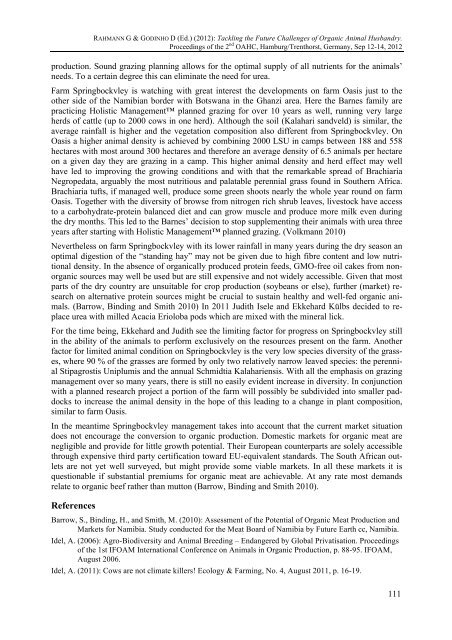Tackling the future challenges of Organic Animal Husbandry - vTI
Tackling the future challenges of Organic Animal Husbandry - vTI
Tackling the future challenges of Organic Animal Husbandry - vTI
Create successful ePaper yourself
Turn your PDF publications into a flip-book with our unique Google optimized e-Paper software.
RAHMANN G & GODINHO D (Ed.) (2012): <strong>Tackling</strong> <strong>the</strong> Future Challenges <strong>of</strong> <strong>Organic</strong> <strong>Animal</strong> <strong>Husbandry</strong>.<br />
Proceedings <strong>of</strong> <strong>the</strong> 2 nd OAHC, Hamburg/Trenthorst, Germany, Sep 12-14, 2012<br />
production. Sound grazing planning allows for <strong>the</strong> optimal supply <strong>of</strong> all nutrients for <strong>the</strong> animals’<br />
needs. To a certain degree this can eliminate <strong>the</strong> need for urea.<br />
Farm Springbockvley is watching with great interest <strong>the</strong> developments on farm Oasis just to <strong>the</strong><br />
o<strong>the</strong>r side <strong>of</strong> <strong>the</strong> Namibian border with Botswana in <strong>the</strong> Ghanzi area. Here <strong>the</strong> Barnes family are<br />
practicing Holistic Management planned grazing for over 10 years as well, running very large<br />
herds <strong>of</strong> cattle (up to 2000 cows in one herd). Although <strong>the</strong> soil (Kalahari sandveld) is similar, <strong>the</strong><br />
average rainfall is higher and <strong>the</strong> vegetation composition also different from Springbockvley. On<br />
Oasis a higher animal density is achieved by combining 2000 LSU in camps between 188 and 558<br />
hectares with most around 300 hectares and <strong>the</strong>refore an average density <strong>of</strong> 6.5 animals per hectare<br />
on a given day <strong>the</strong>y are grazing in a camp. This higher animal density and herd effect may well<br />
have led to improving <strong>the</strong> growing conditions and with that <strong>the</strong> remarkable spread <strong>of</strong> Brachiaria<br />
Negropedata, arguably <strong>the</strong> most nutritious and palatable perennial grass found in Sou<strong>the</strong>rn Africa.<br />
Brachiaria tufts, if managed well, produce some green shoots nearly <strong>the</strong> whole year round on farm<br />
Oasis. Toge<strong>the</strong>r with <strong>the</strong> diversity <strong>of</strong> browse from nitrogen rich shrub leaves, livestock have access<br />
to a carbohydrate-protein balanced diet and can grow muscle and produce more milk even during<br />
<strong>the</strong> dry months. This led to <strong>the</strong> Barnes’ decision to stop supplementing <strong>the</strong>ir animals with urea three<br />
years after starting with Holistic Management planned grazing. (Volkmann 2010)<br />
Never<strong>the</strong>less on farm Springbockvley with its lower rainfall in many years during <strong>the</strong> dry season an<br />
optimal digestion <strong>of</strong> <strong>the</strong> “standing hay” may not be given due to high fibre content and low nutritional<br />
density. In <strong>the</strong> absence <strong>of</strong> organically produced protein feeds, GMO-free oil cakes from nonorganic<br />
sources may well be used but are still expensive and not widely accessible. Given that most<br />
parts <strong>of</strong> <strong>the</strong> dry country are unsuitable for crop production (soybeans or else), fur<strong>the</strong>r (market) research<br />
on alternative protein sources might be crucial to sustain healthy and well-fed organic animals.<br />
(Barrow, Binding and Smith 2010) In 2011 Judith Isele and Ekkehard Külbs decided to replace<br />
urea with milled Acacia Erioloba pods which are mixed with <strong>the</strong> mineral lick.<br />
For <strong>the</strong> time being, Ekkehard and Judith see <strong>the</strong> limiting factor for progress on Springbockvley still<br />
in <strong>the</strong> ability <strong>of</strong> <strong>the</strong> animals to perform exclusively on <strong>the</strong> resources present on <strong>the</strong> farm. Ano<strong>the</strong>r<br />
factor for limited animal condition on Springbockvley is <strong>the</strong> very low species diversity <strong>of</strong> <strong>the</strong> grasses,<br />
where 90 % <strong>of</strong> <strong>the</strong> grasses are formed by only two relatively narrow leaved species: <strong>the</strong> perennial<br />
Stipagrostis Uniplumis and <strong>the</strong> annual Schmidtia Kalahariensis. With all <strong>the</strong> emphasis on grazing<br />
management over so many years, <strong>the</strong>re is still no easily evident increase in diversity. In conjunction<br />
with a planned research project a portion <strong>of</strong> <strong>the</strong> farm will possibly be subdivided into smaller paddocks<br />
to increase <strong>the</strong> animal density in <strong>the</strong> hope <strong>of</strong> this leading to a change in plant composition,<br />
similar to farm Oasis.<br />
In <strong>the</strong> meantime Springbockvley management takes into account that <strong>the</strong> current market situation<br />
does not encourage <strong>the</strong> conversion to organic production. Domestic markets for organic meat are<br />
negligible and provide for little growth potential. Their European counterparts are solely accessible<br />
through expensive third party certification toward EU-equivalent standards. The South African outlets<br />
are not yet well surveyed, but might provide some viable markets. In all <strong>the</strong>se markets it is<br />
questionable if substantial premiums for organic meat are achievable. At any rate most demands<br />
relate to organic beef ra<strong>the</strong>r than mutton (Barrow, Binding and Smith 2010).<br />
References<br />
Barrow, S., Binding, H., and Smith, M. (2010): Assessment <strong>of</strong> <strong>the</strong> Potential <strong>of</strong> <strong>Organic</strong> Meat Production and<br />
Markets for Namibia. Study conducted for <strong>the</strong> Meat Board <strong>of</strong> Namibia by Future Earth cc, Namibia.<br />
Idel, A. (2006): Agro-Biodiversity and <strong>Animal</strong> Breeding – Endangered by Global Privatisation. Proceedings<br />
<strong>of</strong> <strong>the</strong> 1st IFOAM International Conference on <strong>Animal</strong>s in <strong>Organic</strong> Production, p. 88-95. IFOAM,<br />
August 2006.<br />
Idel, A. (2011): Cows are not climate killers! Ecology & Farming, No. 4, August 2011, p. 16-19.<br />
111

















